5 Tips to Reduce Employee No Call No Shows in BPOs
In this article, you will learn about discover 5 actionable strategies to reduce employee no call no shows in BPOs and improve workplace productivity.
5 min read
How to reduce employee no call no shows in BPOs is a pressing concern among HR managers and operations managers alike.
In a Business Process Outsourcing (BPO) environment, where efficiency and reliability are crucial, the sudden absence of an employee can trigger a cascade of operational disruptions. These unexpected “no show” instances not only impact immediate workflow but also strain remaining staff, frequently leading to diminished morale, missed deadlines, and compromised client satisfaction.
According to research, nearly one-quarter of surveyed organizations reported that scheduled absences, which include no call no shows, impact productivity levels significantly. Furthermore, SHRM reports that unscheduled absenteeism costs roughly $3,600 per year for each hourly worker.
The cost and disruption are particularly pronounced in BPOs, where shifts are often tightly scheduled, and client interactions can’t wait. Therefore, reducing no call no shows is vital for maintaining optimum operational efficiency and customer satisfaction in BPOs.
In this post, we’ll explore five practical tips to mitigate the challenge of employee no call no shows in your BPO setting.
From bolstering your communication strategies to leveraging technology, these methods are backed by research and industry best practices. By the end of this blog, you’ll have actionable insight into strategies that can help reduce these disruptions significantly, ensuring a smooth, efficient operation.
Let’s dive into it!
1. Improve Communication Channels
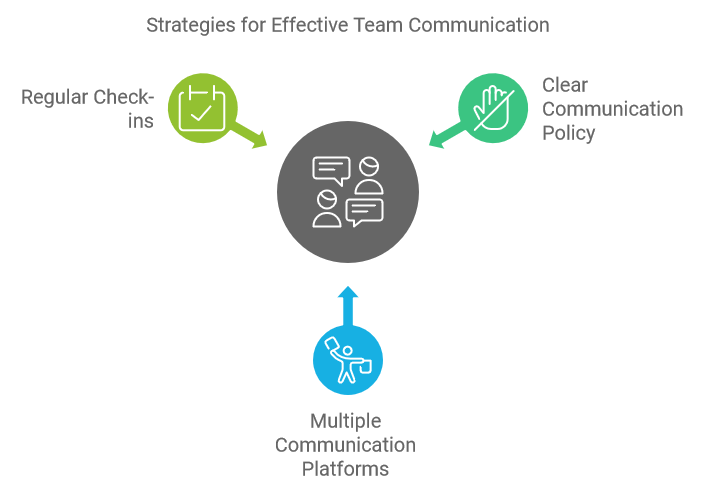
Effective team communication is the bedrock of operational efficiency. Many no call no shows arise from misunderstandings or miscommunications about schedules, policies, or expectations.
- Implement a Clear Communication Policy: Ensure that every employee understands how to communicate absences, whom to contact, and the procedure to follow. This should be included in the employee handbook and reiterated during training sessions.
- Use Multiple Communication Platforms: Relying solely on email or phone calls is outdated. Utilize multiple channels like instant messaging apps (e.g., Slack), internal social platforms, and hotline numbers to ensure messages are received and acknowledged.
- Regular Check-ins: Schedule regular check-ins between managers and their teams to discuss any concerns or upcoming absences. This can prevent potential no call no shows by addressing issues proactively.
Pro Tip
Consider implementing a pulse survey tool to gather regular feedback on communication effectiveness. These tools can help gauge employee engagement and identify communication gaps before they result in no shows.
2. Foster a Positive Work Environment
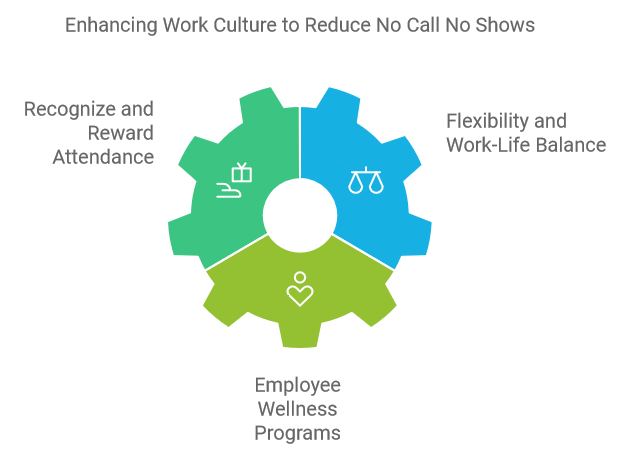
- Recognize and Reward Attendance: Implement an attendance reward program that recognizes employees with exemplary attendance. This can include bonuses, extra time off, or public acknowledgment.
- Flexibility and Work-Life Balance: Offering flexible working arrangements can go a long way in improving attendance. Flexibility can reduce stress and make employees more willing to show up consistently.
- Employee Wellness Programs: Incorporate comprehensive wellness programs focusing on mental and physical health. Healthier employees are less likely to suffer from the types of issues that may lead to unscheduled absences.
Pro Tip
Implement engagement software like TINYpulse, which continuously measures employee satisfaction and can lead to actionable insights for improving workplace culture.
3. Enhance Schedule Flexibility and Planning
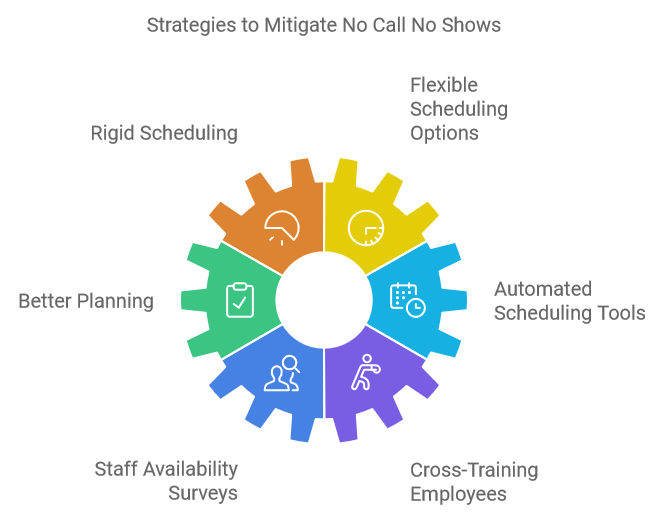
Rigid scheduling can contribute to no call no shows. Offering flexible scheduling options and better planning can help mitigate this issue.
- Automated Scheduling Tools: Use automated employee shift scheduling software such as HiveDesk to streamline shift management, reducing the likelihood of errors and misunderstandings.
- Staff Availability Surveys: Regularly survey employees to understand their availability preferences. Match employee availability with peak operation times to reduce conflicts.
- Cross-Training Employees: Train multiple employees to handle various roles. This ensures that workforce disruption is minimized when someone is absent unexpectedly.
Pro Tip
Leverage AI-powered forecasting tools to predict staffing needs accurately. These apps can help to ensure you have the right number of people scheduled at the right times.
4. Implement Attendance Management Systems
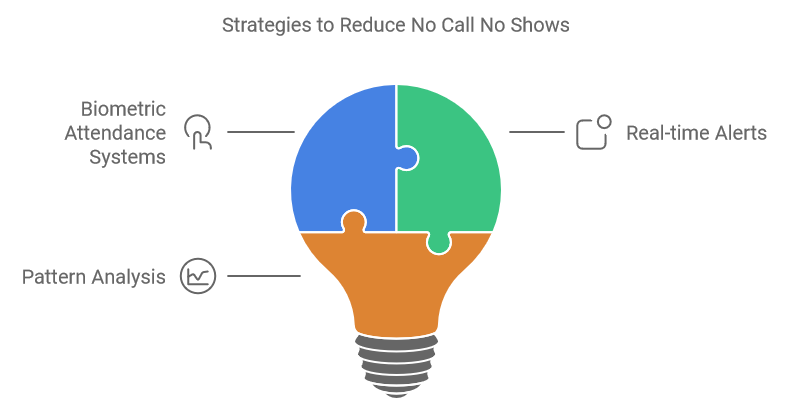
- Biometric Attendance Systems: Employ biometric systems to ensure accurate recording of attendance and reduce fraudulent timekeeping.
- Real-time Alerts: Use systems that send real-time alerts to supervisors when an employee does not check in on time.
- Pattern Analysis: Utilize analytics to identify patterns in absenteeism. This can help in preemptively addressing chronic absenteeism issues.
Pro Tip
Integrate your attendance tracking software with your HR software. Centralized HR systems facilitate comprehensive management by making data available in one centralized platform.
5. Provide Support and Encouragement for Open Communication
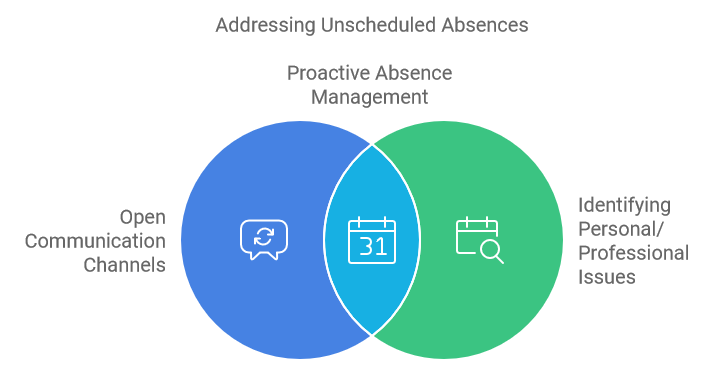
Open communication channels can help identify personal or professional issues that might lead to unscheduled absences.
- Anonymous Feedback Options: Provide channels for employees to give anonymous feedback if they are uncomfortable discussing issues openly. This can include online forms or suggestion boxes.
- Transparent Communication Culture: Cultivate a culture where employees feel safe discussing issues without fear of retribution. This fosters an open dialogue about attendance-related problems.
- Mental Health Resources: Offer mental health resources and counseling services. Ensure employees know how to access these resources when they need support.
Pro Tip
Regularly hold "town hall" meetings where employees can discuss concerns openly with management. This not only addresses issues but also builds trust and transparency.
By addressing the root causes and implementing these strategies, BPOs can significantly reduce employee no call no shows, resulting in smoother operations and better service delivery. Remember, prevention is always better than cure.
Proactively managing attendance, fostering a positive work environment, and leveraging the right tools can make a world of difference.



